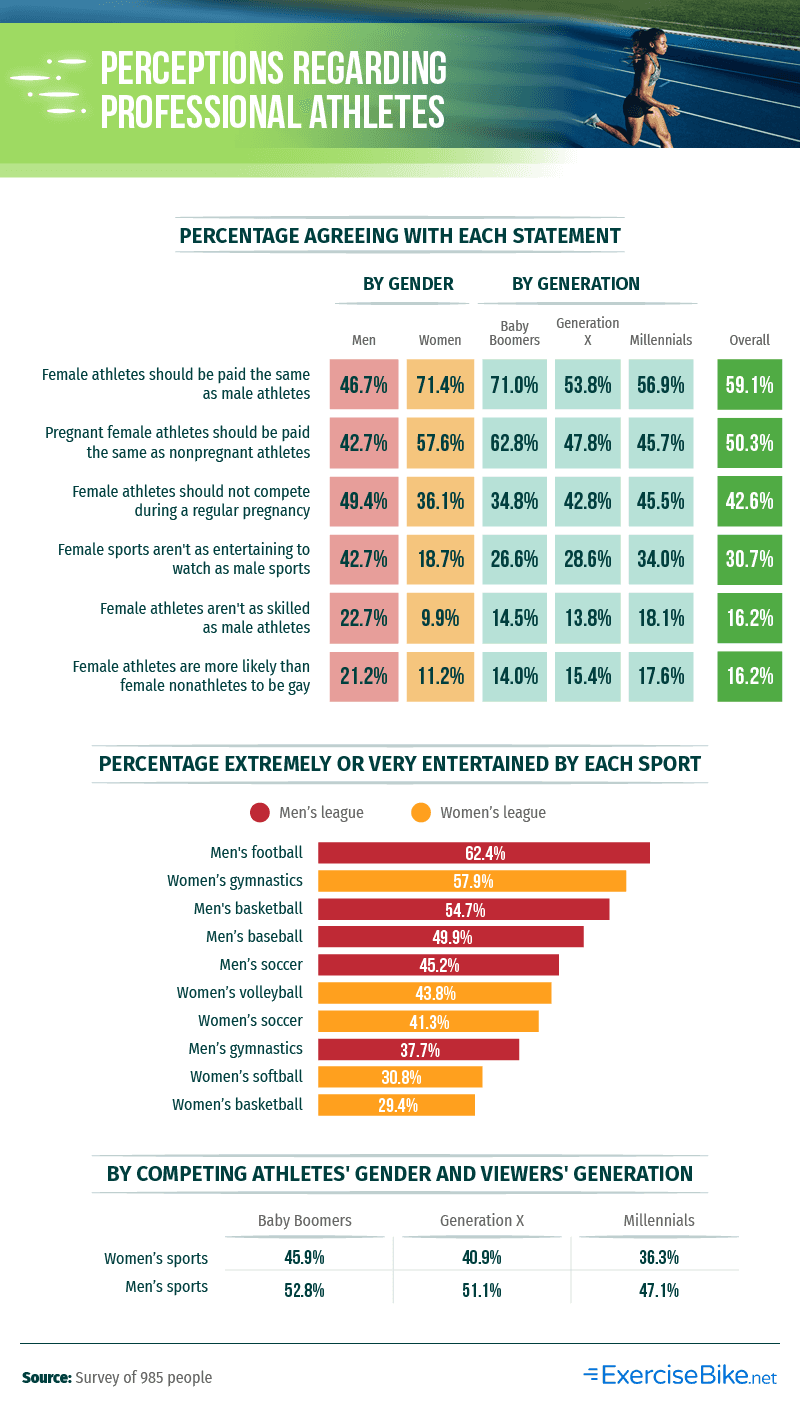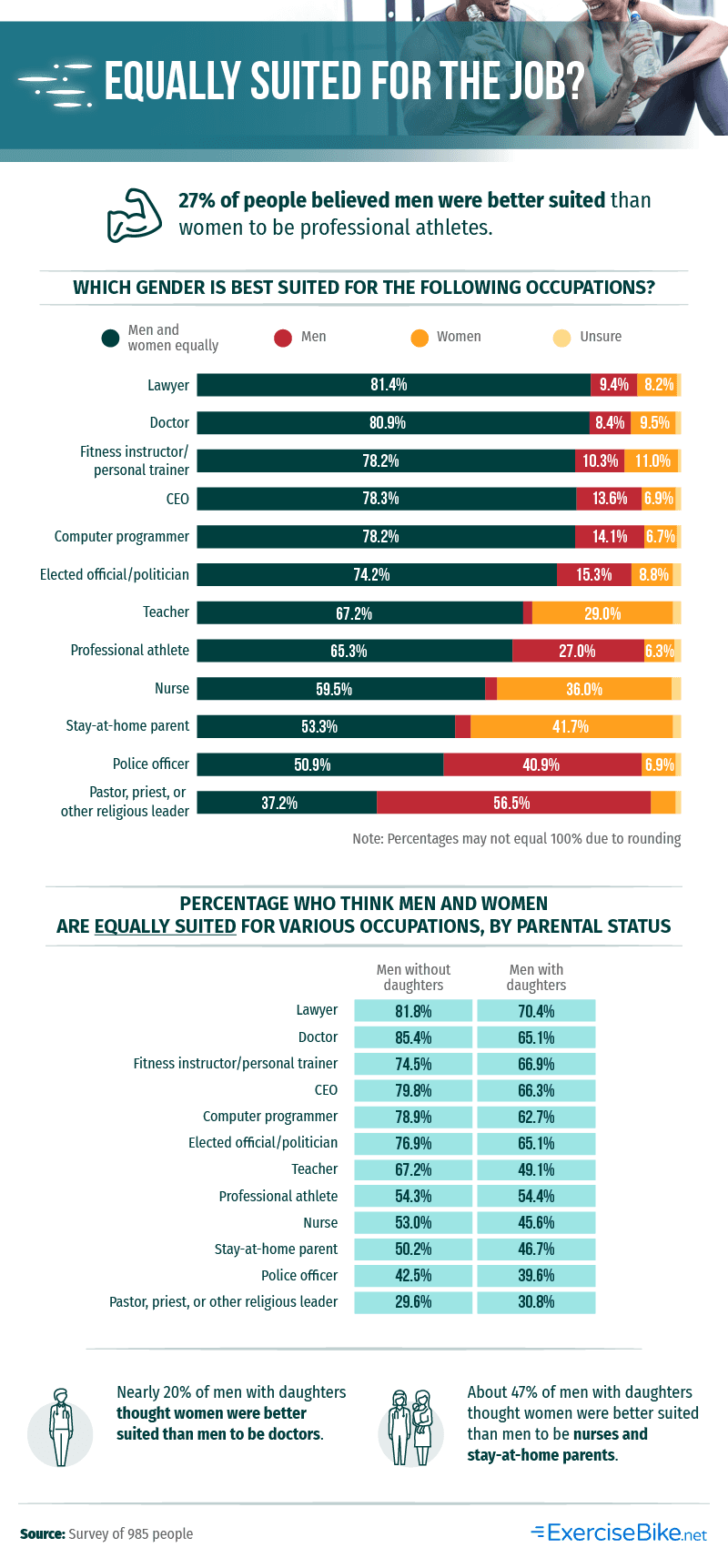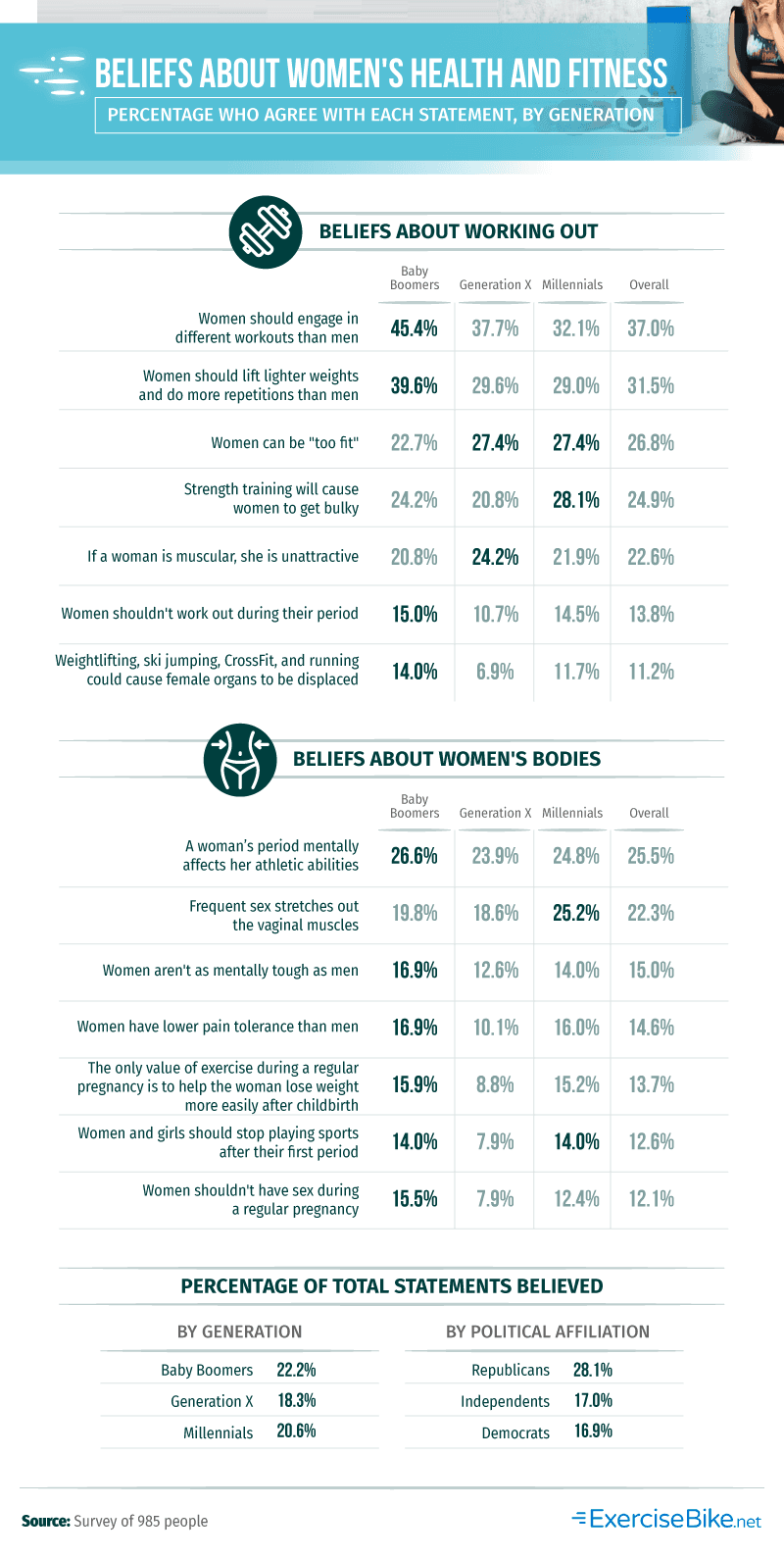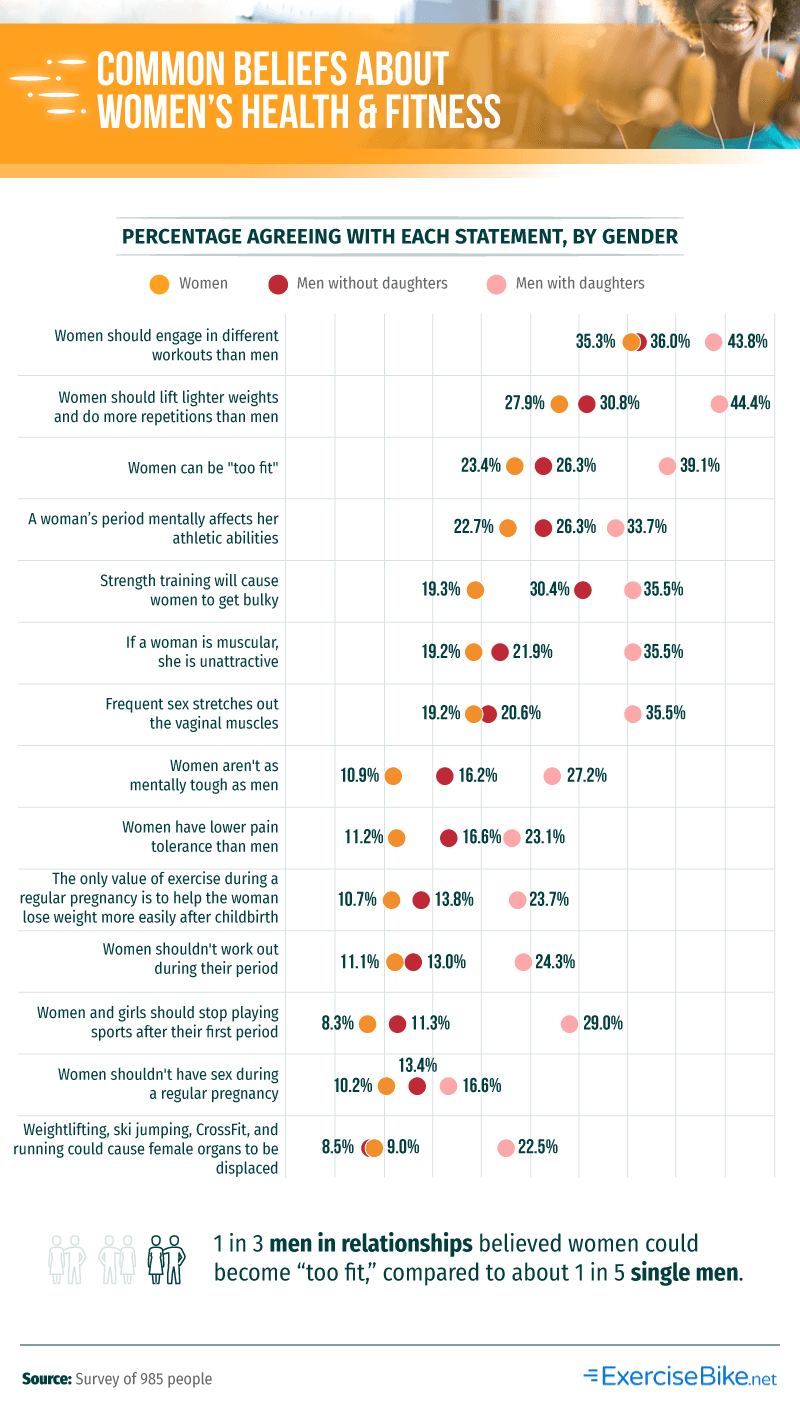Serena Williams won her 23rd Grand Slam at 20 weeks pregnant. Though Williams has long been recognized as one of the greatest athletes of all time, sporting a baby bump during the Australian Open made one thing abundantly clear: Women are powerful.
The tennis professional isn’t alone in her fitness breakthrough. Beyoncé dropped jaws when she spent eight post-pregnancy months rehearsing for Beychella after having suffered from high blood pressure, toxemia, and preeclampsia during her pregnancy.
Yet, society sets the expectation that women aren’t able to accomplish fitness goals simply because they are women. Blaming society is an easy out, so who exactly believes women are less physically able because of their gender, and what are the most popular myths?
We surveyed 985 people to better understand common perceptions about women’s health and anatomy as they relate to fitness. Our findings are broken down by gender, but we also touch on generational and political perceptions.
Great Pay Debate
The U.S. women’s soccer team spent an exciting few weeks scoring goals on the field and trending on Twitter. They won the World Cup title and used their clout to continue demanding equal pay.
According to our study, 71.4% of women and 46.7% of men said male and female athletes should be paid equally– and the pressure is on, U.S. Soccer Federation. Seventy-one percent of baby boomers – the most of any generation – agreed that female athletes should be paid the same as their male counterparts.
What about when women get pregnant? Though Serena Williams made pregnancy fitness popular, only 42.7% of men and 57.6% of women thought pregnant and nonpregnant athletes should be paid equally.
Who’s Suited for the Job?
The whole “barefoot and pregnant” trope has been around for generations, but are we now at the point where women and men can agree that they are equally suited for most occupations? Largely, yes, and many CEOs are more aware of the need to achieve gender equality in their companies.
From police officers to doctors, the majority of our respondents were likely to believe that men and women were equally suited for most occupations. However, 27% felt that men were better suited than women to be professional athletes.
When it came to the occupations that women are better suited for, 41.7% said stay-at-home parent, 36% said nurse, and 29% said teacher. Conversely, 56.5% said men were better suited to be religious leaders, and 40.9% said they were better suited than women to be police officers.
According to the Association of American Medical Colleges, 50.7% of women enrolled in U.S. medical schools compared to 49.8% of men in 2017. Healthline found this development newsworthy because women were considered “too irrational or delicate to perform the work of doctors” just a couple of centuries ago.
The men in our study who have daughters also disagreed with this old way of thinking. Nearly 20% of men with daughters held the opinion that women are better suited than men to be doctors. That’s right: Not only do fathers of daughters believe their little girls can be medical professionals, but they also believe women are better suited for the work.
Overall, women were more likely to believe that both genders were equally suited to perform the occupations listed in our study.
Popular Myths About Women’s Bodies
Serena Williams has graced the cover of well-known magazines like Vanity Fair, ESPN, and Harper’s Bazaar nude several times throughout her career. Each time she’s seen in a popular magazine wearing nothing but her muscles, an internet debate erupts: She’s too fit.
More than 1 in 4 millennials and Gen Xers agreed that women can be too fit, but only 22.7% of baby boomers concurred. However, at 45.4%, baby boomers were more likely than other generations to believe that women should do different fitness workouts than men. It gets even more interesting: 11.2% of respondents agreed that sports like weightlifting, ski jumping, CrossFit, and running could cause female organs to be displaced.
When it came time to discuss Aunt Flo, 26.6% of baby boomers and 24.8% of millennials said a woman’s period affects her athletic abilities. The U.S. women’s soccer team has taken this social belief on like a head-butt, with Coach Dawn Scott advocating to end the taboo not only at the elite level but also for young female athletes.
Does Having a Daughter Make a Difference?
What if she were your daughter? That question often comes up when men make insensitive comments about women. According to our findings, fathers of daughters tend to believe more myths about women’s health and fitness than men without daughters.
Of our respondents with daughters, 44.4% thought women should lift lighter weights and do more repetitions than men, compared to 30.8% of men without daughters. The percentage of stay-at-home dads has remained below 20% for the last three decades, so one might assume that men have seen less of their children’s capabilities.
What did women have to say in all of this? To start, only 27.9% of female respondents thought women should lift lighter weights and do more repetitions than men. And when it came to being mentally tough and pain tolerant, the women in our study overwhelmingly disagreed that men are tougher. Compared to 27.2% of men with daughters and 16.2% of men without daughters, only 10.9% of women agreed that their gender is not as mentally tough as men.
Time to Break the Myths
Getting to a place where women won’t have to fight for equal pay in the boardroom and on the turf may take a few more years. Our findings reveal that several misconstrued myths about women and their physical capabilities persist. From beliefs about women being less mentally tough to the idea that they deserve less pay than men, both genders and the three generations studied shared in these misconceptions.
Whether you’re a woman or a man, ExerciseBike.net has all the in-depth exercise bike reviews you need to get you closer to a fitter lifestyle. We know finding the right exercise equipment is half the fitness journey, so we’ve sorted the exercise bikes by price, quality, customer support, and other important factors. Explore our site and find the ride that meets your needs.
Methodology and Limitations
We surveyed 985 individuals; 49.4% were men, 50.4% were women, and 0.2% were nonbinary. Of the men, 40.6% had at least one daughter, and 59.4% did not. The average age of men with daughters was 41.6 and those without daughters was 37.7.
In terms of age, 22.9% were baby boomers, 33.8% were Gen Xers, and 38.6% were millennials. The remaining 4.8% of respondents were of other generations. The average age was 40.6, and the standard deviation was 13. Participants ranged in age from 18 to 78. 36.8% of participants identified as Democrats, 35.1% as Republicans, and 28.1% as Independents.
When we compared sample sizes to the total population (based on 2017 U.S. Census Bureau figures) our confidence level was 95%, and margins of error were 7% for baby boomers, 5% for Generation X, and 5% for millennials. The margin of error was 4% for both women and men. Based on 2018 voter registrations, our margins of error for political parties were 5% for Democrats, 5% for Republicans, and 6% for Independents. The confidence level was 95%.
We compiled a list of statements to include in our survey through research, crowdsourcing, and by considering current events as they relate to women. Since this study is based on self-reported data, there could be issues such as exaggeration, telescoping, and minimization. Data were neither weighted nor statistically tested.
Fair Use Statement
Be a good sport: Share this material and any of its graphics for noncommercial purposes, but we ask that you cite the authors and link back to this page when doing so.





